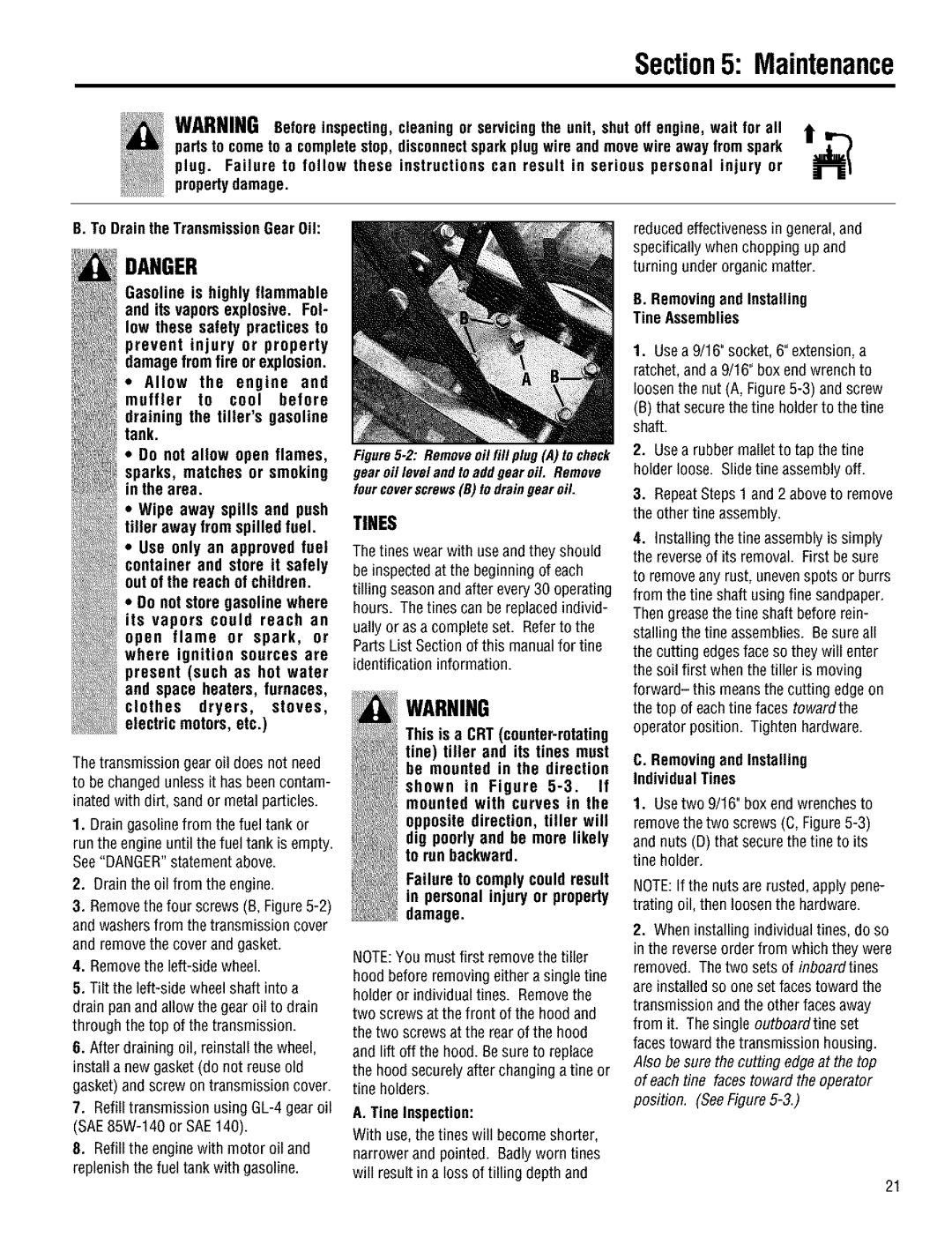
Section5: Maintenance
WARNINGBefore inspecting, cleaning or servicing the unit, shut off engine, wait for all | I" |
parts to come to a completestop, disconnectspark plug wire and movewire away from spark | ....t....[ |
plug. Failure to follow these instructions can result in serious personal injury or |
|
propertydamage. |
|
B. To Drain the TransmissionGear Oil:
DANGER
Gasoline is highly flammable and its vapors explosive. Fol- low these safety practices to prevent injury or property damage from fire or explosion.
•Allow the engine and
muffler to cool before
draining the tiller's gasoline tank.
•Do not allow open flames, sparks, matches or smoking in the area.
•Wipe away spills and push tiller away from spilled fuel.
•Use only an approved fuel container and store it safely out of the reach of children.
•Do not store gasoline where its vapors could reach an open flame or spark, or where ignition sources are present (such as hot water and space heaters, furnaces,
clothes dryers, stoves, electric motors, etc.)
The transmission gear oil does not need to bechanged unless it has beencontam- inated with dirt, sand or metal particles.
1. Drain gasolinefrom the fuel tank or
run the engine until the fuel tank is empty. See"DANGER"statement above.
2.Drain the oil from the engine.
3.Removethe four screws (B,
and removethe cover and gasket.
4.Removethe
5.Tilt the
drain panand allow the gear oil to drain through the top of the transmission.
6.Nter draining oil, reinstall the wheel, install a new gasket (do not reuse old gasket) and screw on transmission cover.
7.Refill transmission using
8.Refill the enginewith motor oil and replenish the fuel tank with gasoline.
Figure5-2: Removeoilfill plug(A)tocheck gearoil levelandtoaddgearoil, Remove fourcoverscrews(B)to draingearoil.
TINES
The tines wear with use and they should beinspected at the beginning of each tilling seasonand after every30 operating hours. The tines can be replaced individ-
ually or as a complete set. Referto the Parts List Section of this manualfor tine
identification information.
WARNING
This is a CRT
shown in Figure
opposite direction, tiller will dig poorly and be more likely to run backward.
Failure to comply could result in personal injury or property damage.
NOTE:You must first remove the tiller
hood before removing either a single tine holder or individual tines. Removethe two screws at the front of the hood and the two screws at the rear of the hood
and lift off the hood. Besure to replace
the hood securely after changing a tine or tine holders.
A. Tine Inspection:
With use, the tines will becomeshorter, narrower and pointed. Badly worn tines will result in a loss of tilling depth and
reduced effectivenessin general,and specifically when chopping up and
turning under organic matter.
B.Removingand Installing Tine Assemblies
1.Usea 9/16" socket, 6" extension, a ratchet,and a 9/16" box end wrench to loosen the nut (A, Figure
(B)that secure the tine holder to the tine shaft.
2.Usea rubber mallet to tap the tine holder loose. Slidetine assembly off.
3.RepeatSteps1 and 2 aboveto remove the other tine assembly.
4.Installing the tine assembly is simply the reverseof its removal. First besure
to removeany rust, unevenspots or burrs from the tine shaft using fine sandpaper. Then greasethe tine shaft before rein- stalling the tine assemblies. Be sure all the cutting edgesface so they will enter the soil first when the tiller is moving forward- this means the cutting edge on the top of eachtine faces towardthe operator position. Tighten hardware.
C.Removingand Installing Individual Tines
1.Usetwo 9/16" box endwrenches to
removethe two screws (C, Figure
NOTE:If the nuts are rusted, apply pene- trating oil, then loosen the hardware.
2.When installing individual tines, do so in the reverseorder from which they were removed. The two sets of inboardtines are installed so one set faces toward the transmission and the other faces away from it. The single outboardtine set
faces toward the transmission housing. Also be sure the cutting edge at the top of each fine faces toward the operator position. (See Figure
21
